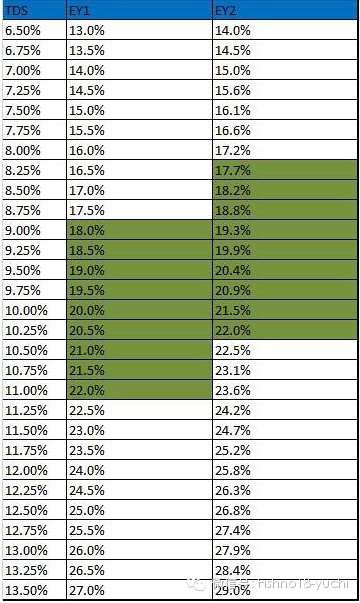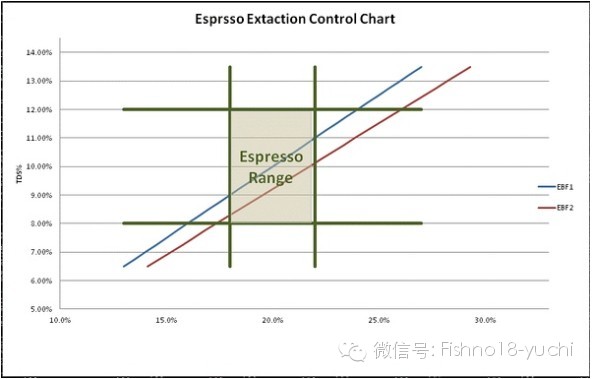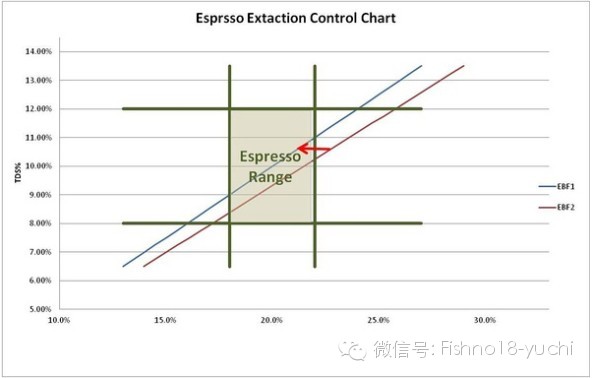Effect of Powder content on Coffee in Coffee production
1. The concentration determines the richness of the coffee. It is the soluble matter that determines the concentration. (it is worth mentioning that XLW007 in the common sense group mentioned that insoluble matter can also increase the thickness of caffeine. I totally agree, but this time I only focus on the main cause of soluble matter.) and its calculation can be measured by a concentration photorefractometer:
TDS%= TDS/Coffee Weight the percentage of soluble matter is the gram weight of soluble matter divided by the total weight of coffee.
two。 And this part of the soluble matter comes from the amount of coffee powder. So, we can get the extraction rate (extraction yield).
EY= TDS/DOSE is the gram weight of the soluble matter divided by the amount of powder used, and we know the percentage of how much has been extracted. In most cases, whether it is Italian concentrated coffee or hand-brewed coffee, the reasonable extraction rate is 18-21%.
I went through a little review. Now, starting with the amount of powder as the core, we will see how the amount of powder affects the flavor of coffee. Before that, let's take the high-end Mazzer Robur electric grinder in the market as an example. In my previous diary, if there is no powder, there can be a difference of about 2.3g between the minimum powder and the maximum powder. Let's just take this as an example, 2.3g, there seems to be only a "10%" difference in powder quantity, how different we will be in production.
Here, we make another assumption, that is, according to the traditional production method, the extraction will be stopped as soon as we reach the double espresso of 60ml. At the same time, for the convenience of calculation, it is assumed that the coffee weight of 60Ml is all the same. This is a limitation, just for ease of understanding.
Here, the parameters we assume
The amount of powder is 1g.
Powder content 2: 19g
The weight of coffee extracted from 60ml is 38g.
And the coffee is relatively fresh and standard medium roasting. Moreover, there is no problem with our pressing powder, and the extraction is uniform.
We can get the following parameters, as shown in the figure:


1. The concentration determines the richness of the coffee. It is the soluble matter that determines the concentration. (it is worth mentioning that XLW007 in the common sense group mentioned that insoluble matter can also increase the thickness of caffeine. I totally agree, but this time I only focus on the main cause of soluble matter.) and its calculation can be measured by a concentration photorefractometer:
TDS%= TDS/Coffee Weight the percentage of soluble matter is the gram weight of soluble matter divided by the total weight of coffee.
two。 And this part of the soluble matter comes from the amount of coffee powder. So, we can get the extraction rate (extraction yield).
EY= TDS/DOSE is the gram weight of the soluble matter divided by the amount of powder used, and we know the percentage of how much has been extracted. In most cases, whether it is Italian concentrated coffee or hand-brewed coffee, the reasonable extraction rate is 18-21%.
I went through a little review. Now, starting with the amount of powder as the core, we will see how the amount of powder affects the flavor of coffee. Before that, let's take the high-end Mazzer Robur electric grinder in the market as an example. In my previous diary, if there is no powder, there can be a difference of about 2.3g between the minimum powder and the maximum powder. Let's just take this as an example, 2.3g, there seems to be only a "10%" difference in powder quantity, how different we will be in production.
Here, we make another assumption, that is, according to the traditional production method, the extraction will be stopped as soon as we reach the double espresso of 60ml. At the same time, for the convenience of calculation, it is assumed that the coffee weight of 60Ml is all the same. This is a limitation, just for ease of understanding.
Here, the parameters we assume
The amount of powder is 1g.
Powder content 2: 19g
The weight of coffee extracted from 60ml is 38g.
And the coffee is relatively fresh and standard medium roasting. Moreover, there is no problem with our pressing powder, and the extraction is uniform.
We can get the following parameters, as shown in the figure:

As shown in the picture, the increased amount of powder makes the coffee that was previously overextracted become a normal extraction.
Revelation:
There is also a very important revelation, generally the same kind of coffee beans, the deeper the roasting degree, the higher the alcohol thickness corresponding to the same extraction parameters. On the other hand, in today's era of shallow baking, shallow baked espresso can reflect strong floral, citrus and other fruit flavors. But the bitter balance and the full thickness of alcohol are a great challenge. Compared with deep-roasted coffee beans, the extraction efficiency of light-roasted coffee beans is relatively low. That is, the concentration of shallow baking is often on the low side with the same amount of powder and the same extraction time. On the other hand, a low concentration can make the plumpness of light-roasted coffee a hard wound.
We can see from this picture that if only 17.7g powder is used, if it reaches 11%, it already means over-extraction. Therefore, this can more or less explain that if a small filter bowl with a small amount of powder is equipped with a coffee machine, it is not recommended to try light-roasted coffee beans. This also explains that Melbourne's shallow baking Axil uses a 22gVST filter bowl to make a double espresso! And the 22g filter bowl can actually add the powder to 25g!
As a barista, first of all, you should know how to taste and judge, and then adjust accordingly through the balance of sour, bitterness and mellow. And the amount of powder at least in this chapter can be seen, it is an important tool.
Of course, I used a 10% error to express this problem today. In fact, an error of 0.5g is enough to change the flow rate, and if you can limit your powder to less than 0.3g, you may:
1. Make each cup of coffee consistent.
two。 Accordingly, learn to fine-tune and adjust its flavor.
3. Combined with the amount of powder adjustment, and then understand the impact of grinding degree and extraction time on the flavor of coffee, you can give coffee production more control.
Important Notice :
前街咖啡 FrontStreet Coffee has moved to new addredd:
FrontStreet Coffee Address: 315,Donghua East Road,GuangZhou
Tel:020 38364473
- Prev

How to make coffee in a mocha pot
1. No matter what kind of mocha pot, whether single valve or double valve, you should choose Italian matching beans, that is, deep-baked matching beans. Because the mocha pot is a method of extracting coffee with high temperature and high pressure, the strong flavor of coffee is determined by its own method, which cannot be changed by man. If you choose a single bean that is light or medium-baked, it must be bitter and astringent.
- Next

The source of coffee, the method of making and blending coffee, and matters needing attention.
Coffee is the transliteration of English Coffee. It is a drink made from roasted coffee beans, ground into powder and then brewed. (1) A brief introduction to Coffee 1. The origin of coffee Coffee originated in Ethiopia in Africa. There are many theories about discovering it, among which a legend accepted by most people is that about 3000 years ago, a shepherd saw the sheep he was herding ate a kind of nameless food.
Related
- What is the meaning of lactic acid fermentation with coffee bean treatment?
- How to judge the state of foam by sound?
- How does the latte pull out the unicorn pattern? Come to get for a little trick to improve the flower pull!
- Will flower pulling affect the taste of the latte?
- Do you know the history of coffee?
- The difference between honey treatment and sun washing what is raisin honey treatment?
- What kind of milk can a novice use to make coffee foam to keep the foam longer? The correct method and skills of milking tutorial sharing
- Why do washed coffee beans taste sour? Flavor characteristics of washed Coffee
- Introduction to the skill of how to practice the size and height of water injection around the circle of hand-brewed coffee
- How do beginners practice coffee flower drawing from scratch?

